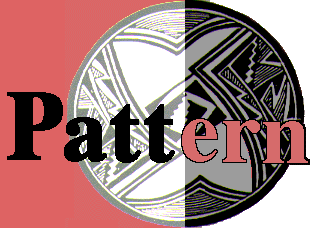
 |
Lesson 1:
|
|
Lesson 1 Ritual Geometry Mandala Lesson 2 Group Elements Color Theory Lesson 3 Groups and Groups Acting on Sets Block printing Lesson 4 Klimt and the Computer Color and symmetry in modern art I Lesson 5 Islam Islamic art Lesson 6 Penrose and Rice Color and symmetry in modern art II Lesson 7 Escher 1 Escher 2 Lesson 8 Hundertwasser & Griffeath Pattern and Modern Painting Brian P. Hoke: Cellular Automata and Art Student's Work
|
Goals: To understand that symmetry is a human construction laid upon nature, to distinguish between the symmetric object and the symmetry itself, to understand that symmetries can be labeled, listed, and composed with each other, to construct examples of multiplication tables arising from this activity, and to see some cultural context for the math.
LITTLE, BROWN AND COMPANY p.74, Figure 2.16
In India around 400 B.C., altars in shapes such as this were used for religious purposes. The belief was that, in times of plague, the altar needed to be doubled in size to placate the gods. Consequently, priests were expected to be able to figure out how to double the area of a relatively complex geometric figure. (source: Pi in the Sky) Given that the much simpler problem of doubling the area of a square presupposes knowledge of the Pythagorean theorem (written down by Pythagoras around 550 B.C.E. but in a vastly different place), we can see that priests were also expected to be competent geometers.
Another example of math and religion interacting is the mandala -- a design used for meditation. This one is from at least 600 C.E., but there are examples dating to the 12th century B.C.E.
LITTLE, BROWN AND COMPANY p.76, Figure 2.17
Here symmetry is the crucial mathematical element. The symmetries increase as we move from the center, which has only bilateral symmetry, toward the outer circle, which has infinite symmetry. Correspondingly, the center of the mandala represents order and the realm of the gods, while the outside represents the chaos of the material world. We don't know if the mandalas were created using overt, systematic geometric knowledge or if this is an example of "geometric intuition" on the part of the artist, preceding the formalization of the math. The symmetries of an object such as a mandala can be thought of as objects in themselves. Consider an equilateral triangle and notice that it has six symmetries. If we label them (for example as rotations and flips of different degrees), we can compose them and make a multiplication table, giving them a mathematical structure of their own.
Each group has two mandalas, including a transparency of each. For each of these do the following exercise, write it up and hand it in with your names on it at the end of class. Include a copy of the mandalas and the transparency. Keep a copy of your work for yourself.
This homework is due to at the start of class on July 1, in rough form. You cannot participate in the class activities without it. The final version will be due at the start of class on July 8!
|
 |
|Next - > | |  |